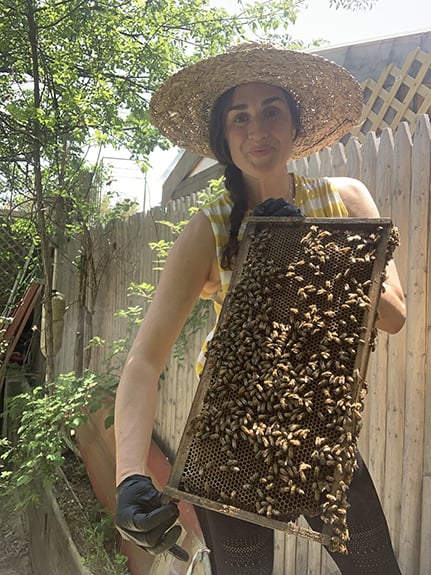There are so many reasons to keep honey bees. For us it’s mostly for pollination and that delicious honey that they magically produce. Keeping bees was once a task that people were intimidated by but these days it’s become so much more accessible and available for just about anyone who wants to give it a go. We have been keeping bees on and off for 5+ years. We work closely with a local master bee-keeper, John Carson who maintains most of the hives on the East End of Long Island. He runs an education program through the Quogue Wildlife Refuge and is a Bee Wizard! I often get the question, “What is happening inside of that hive?” It’s more complicated than I can summarize in this brief article but at a high level here is an idea.

Honey Bees are a Colony of Master Communicators. Every single Bee has a role that they play. Every role is crucial to the success of that hive and its existence. So, who are our players?
Queen Bee: The Queen is the heart and soul of each colony of Bees. Without her the colony can’t survive. She is the largest bee in the hive and responsible for two roles. She produces a chemical scent that helps to regulate unity in the colony and she is responsible for laying eggs, what will one day be the hives brood. A healthy Queen can lay up to 1,500 eggs per day in 30 second intervals.
Worker Bee: The majority of the hive consists of Worker Bees. They are all female and are responsible for a variety of different jobs that can change at a moments notice.
• Housekeeping: Cleaning the cells after a bee emerges for pollen and nectar storage.
• Removal: Keeping the hive clean worker bees will remove any dead bees or invaders that enters it.
Nurse: Once the Queen has laid an egg the nurse bees are responsible for feeding the larva and caring for it.
Royal Attendant: The Queen has a tribe of bees that will help groom her and feed her and they follow her around the hive.
House Bees: They are responsible for taking the nectar and pollen brought in by foragers mixing it with an enzyme and then depositing it into empty clean cells. This, when all of the water content evaporates, will become Honey.
Fanning: Responsible for maintaining the temperature within the hives.
Guard Bee: These bees stand at the entrance to the hive and guard their colony from outside invaders.
Foragers: These are the bees that we see flying from flower to flower gathering pollen and nectar to bring back to the hive.
Drone Bees: Are all males and their single purpose in their life is to mate with a Queen and then they will die.
At any given moment we can assume there is a complex system of communication that is helping to operate what is happening inside the hive as well as outside.The Queen is laying alongside of her tribe cleaning and maintaining the inside of the hive. The foragers are heading out as soon as the sun warms the hive letting them know it’s time to get to work. When they leave the hive they are looking for water, pollen or nectar. Forager bees inform other foragers where pollen, nectar and water are through a dance they do when they return back to the hive. This communication allows them to know where to fly to more efficiently gather the essentials. Once gathered the forager returns back to the hive and transfers mouth to mouth what she has gathered to another house bee in the hive. Pollen and Nectar are then chewed and mixed with a special enzyme in their saliva and deposited into a clean and empty comb cell where water will evaporate and honey will form.
Honey Bees are crucial to our food chain and to our survival. There are so many ways that we can help the conservancy effort. Here are some ideas:
• Plant a pollinator garden with local native plants that are pollinator friendly.
• Try to go as Chemical Free as possible with the products you are using in your garden and on your lawn.
• Create a Bee Bathe — a simple dish with water and some stones or a place a bee can land and drink from.
• Educate our youth about Honey Bees. They are not aggressive or likely to sting you while they are out foraging. Know the difference between a yellow jacket (more aggressive) and a honey bee.
• Buy local honey and help support our local apiaries.
• Sponsor a hive at The Quogue Wildlife Refuge (great gift and way to support).
More resources are available at www.abfnet.org.

Jenn Neubauer can be found in her East End garden year round. Jenn works privately as a Garden Coach mentoring her clients by guiding and supporting them to create and manage edible and pollinator-friendly gardens. @hookandgarden.










![Big news in East End real estate! 🚨 @williamraveis has merged with Town & Country Real Estate, bringing together shared values and ambitious vision. Since 1974, William Raveis has built the largest family-owned brokerage in the Northeast, and now, with the expertise of @judidesiderio and Town & Country, the future of Hamptons real estate is stronger than ever. [link in bio]](https://hamptonsrealestateshowcase.com/wp-content/uploads/sb-instagram-feed-images/476759315_1782460569154569_6635216498348250105_nfull.webp)
![This stunning, modern home offers luxurious living on 1.17± acres with 7 spacious bedrooms and 9.5 elegant bathrooms; a rare opportunity to own an expansive, newly constructed, custom-built home in the Village of Southampton. All overflowing with natural light, 276 N Main Street is ideal for the Hamptons lifestyle. Represented by @aimeebarone of @brownharrisstevens. [link in bio]](https://hamptonsrealestateshowcase.com/wp-content/uploads/sb-instagram-feed-images/476101989_18490248829030135_2567439999744587554_nfull.webp)
![958 Cobb Road W is a striking 6,700± sq. ft. barn-style home that offers 5 bedrooms, 4 baths, a triple height great room with vaulted ceilings, stone fireplace, and dining room. The 3-season porch overlooks the pool while the expansive open lawn is perfect for entertaining al fresco. Represented by @beatemoore of @sothebysrealty. [link in bio]](https://hamptonsrealestateshowcase.com/wp-content/uploads/sb-instagram-feed-images/476095158_18490063498030135_410665094993156774_nfull.webp)
![More than 20 years after Academy Award-winning actor Sidney Poitier scooped up an apartment on Manhattan’s Upper East Side, the park-view duplex residence has popped back up for sale. On the market for $11.5M with @thecorcoangroup's @thechriskannteam. Poitier and his wife, Joanna, paid just $2.5M for the Fifth Avenue pad back in 1994. [link in bio]](https://hamptonsrealestateshowcase.com/wp-content/uploads/sb-instagram-feed-images/476133814_936508641994841_5390207071148792958_nfull.webp)
![Exciting news for coffee lovers! ☕️✨ @hamptoncoffee has just opened its 7th location in Hampton Bays! Swing by for your favorite brews, delicious bites, and that cozy Hamptons vibe. [link in bio]](https://hamptonsrealestateshowcase.com/wp-content/uploads/sb-instagram-feed-images/475911931_1008331407779975_5041581287369529436_nfull.webp)

![Introducing Goose Creek, a revitalized 14± acre waterfront estate nestled along 827± ft. of water frontage at 30 Mathews Road. Crafted in 2010 by the esteemed local builder Ben Krupinski and envisioned by the renowned architect Paul Rice, the grand 10,000± sq. ft. home blurs the lines between indoor and outdoor living. Contact @petrieteam of @compass with all rental inquiries. [link in bio]](https://hamptonsrealestateshowcase.com/wp-content/uploads/sb-instagram-feed-images/475679064_18489177286030135_5241008928583656401_nfull.webp)
